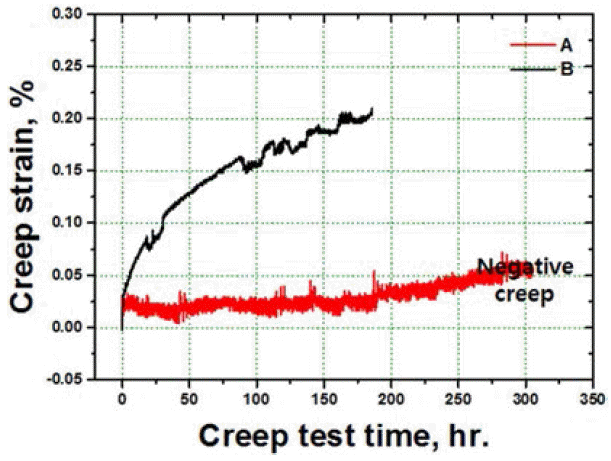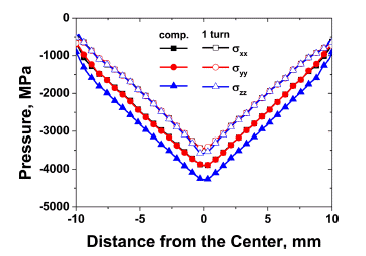Search
- Page Path
- HOME > Search
- [Korean]
- Analyses of Creep Properties of Ni-base Superalloy Powders as Cooling Rate after Solid Solution Heat Treatment
- Chan Jun, Youngseon Lee, Byeong Beom Bae, Hong-Kyu Kim, Seong Suk Hong, Donghoon Kim, Jondo Yun, Eun Yoo Yoon
- J Korean Powder Metall Inst. 2016;23(3):247-253. Published online June 1, 2016
- DOI: https://doi.org/10.4150/KPMI.2016.23.3.247

- 752 View
- 2 Download
-
 Abstract
Abstract
 PDF
PDF In this study, solid solution heat treatment of consolidated nickel-based superalloy powders is carried out by hot isotactic pressing. The effects of the cooling rate of salt quenching, and air cooling on the microstructures and the mechanical properties of the specimens are analyzed . The specimen that is air cooled shows the formation of serrated grain boundaries due to their obstruction by the carbide particles. Moreover, the specimen that is salt quenched shows higher strength than the one that is air cooled due to the presence of fine and close-packed tertiary gamma prime phase. The tensile elongation at high temperatures improves due to the presence of grain boundary serrations in the specimen that is air cooled. On the contrary, the specimen that is salt quenched and consists of unserrated grain boundaries shows better creep properties than the air cooled specimen with the serrated grain boundaries, due to the negative creep phenomenon.
- [Korean]
- Analyses of Densification and Consolidation of Copper Powders during High-Pressure Torsion Process Using Finite Element Method
- Dong Jun Lee, Eun Yoo Yoon
- J Korean Powder Metall Inst. 2015;22(1):6-9. Published online February 1, 2015
- DOI: https://doi.org/10.4150/KPMI.2015.22.1.6

- 654 View
- 2 Download
- 1 Citations
-
 Abstract
Abstract
 PDF
PDF In this study, the behavior of densification of copper powders during high-pressure torsion (HPT) at room temperature is investigated using the finite element method. The simulation results show that the center of the workpiece is the first to reach the true density of copper during the compressive stage because the pressure is higher at the center than the periphery. Subsequently, whole workpiece reaches true density after compression due to the high pressure. In addition, the effective strain is increased along the radius during torsional stage. After one rotation, the periphery shows that the effective strain is increased up to 25, which is extensive deformation. These high pressure and severe strain do not only play a key role in consolidation of copper powders but also make the matrix harder by grain refinement.
-
Citations
Citations to this article as recorded by- Enhanced wear resistivity of a Zr-based bulk metallic glass processed by high-pressure torsion under reciprocating dry conditions
Soo-Hyun Joo, Dong-Hai Pi, Jing Guo, Hidemi Kato, Sunghak Lee, Hyoung Seop Kim
Metals and Materials International.2016; 22(3): 383. CrossRef
- Enhanced wear resistivity of a Zr-based bulk metallic glass processed by high-pressure torsion under reciprocating dry conditions
- [Korean]
- Obtaining Mechanical Properties of Fe Powder Using a Combined Nanoindentation and the Finite Element Method
- Hyeok Jae Jeong, Dong Jun Lee, Eun Yoo Yoon, Eon Sik Lee, Nack Joon Kim, Hyeong Seop Kim
- J Korean Powder Metall Inst. 2013;20(4):280-284.
- DOI: https://doi.org/10.4150/KPMI.2013.20.4.280

- 489 View
- 0 Download
-
 Abstract
Abstract
 PDF
PDF - Stress-strain curves are fundamental properties to study characteristics of materials. Flow stress curves of the powder materials are obtained by indirect testing methods, such as tensile test with the bulk materials and powder compaction test, because it is hard to measure the stress-strain curves of the powder materials using conventional uniaxial tensile test due to the limitation of the size and shape of the specimen. Instrumented nanoindentation can measure mechanical properties of very small region from several nanometers to several micrometers, so nanoindentation technique is suitable to obtain the stress-strain curve of the powder materials. In this study, a novel technique to obtain the stress-strain curves using the combination of instrumented nanoindentation and finite element method was introduced and the flow stress curves of Fe powder were measured. Then obtained stress-strain curves were verified by the comparison of the experimental results and the FEA results for powder compaction test.
- [Korean]
- Trend in Research of Powder Consolidation Using Severe Plastic Deformation
- Eun Yoo Yoon, Dong Jun Lee, Dong-Hyun Ahn, Hyuk Jae Jeong, Hyoung Seop Kim
- J Korean Powder Metall Inst. 2013;20(2):148-154.
- DOI: https://doi.org/10.4150/KPMI.2013.20.2.148

- 533 View
- 2 Download
- 1 Citations
-
 PDF
PDF -
Citations
Citations to this article as recorded by- Analyses of Sever Plastic Deformation Behavior of Hot Isostatic Pressed Ni-base Superalloy during High Pressure Torsion Process
D.J. Lee, Y. Lee, H.-K. Kim, Y.-N. Kwon, H.S. Kim, E.Y. Yoon
Transactions of Materials Processing.2016; 25(4): 254. CrossRef
- Analyses of Sever Plastic Deformation Behavior of Hot Isostatic Pressed Ni-base Superalloy during High Pressure Torsion Process
TOP
 KPMI
KPMI


 First
First Prev
Prev


